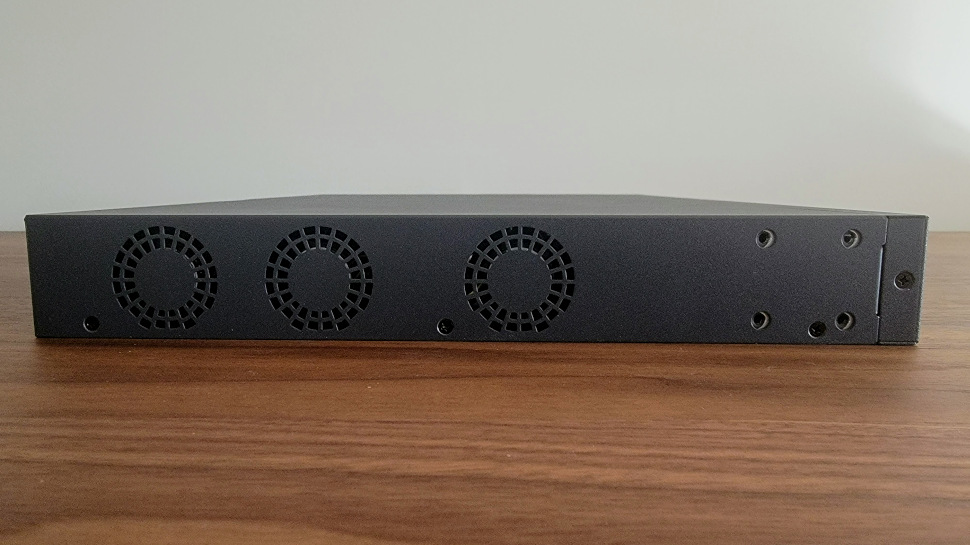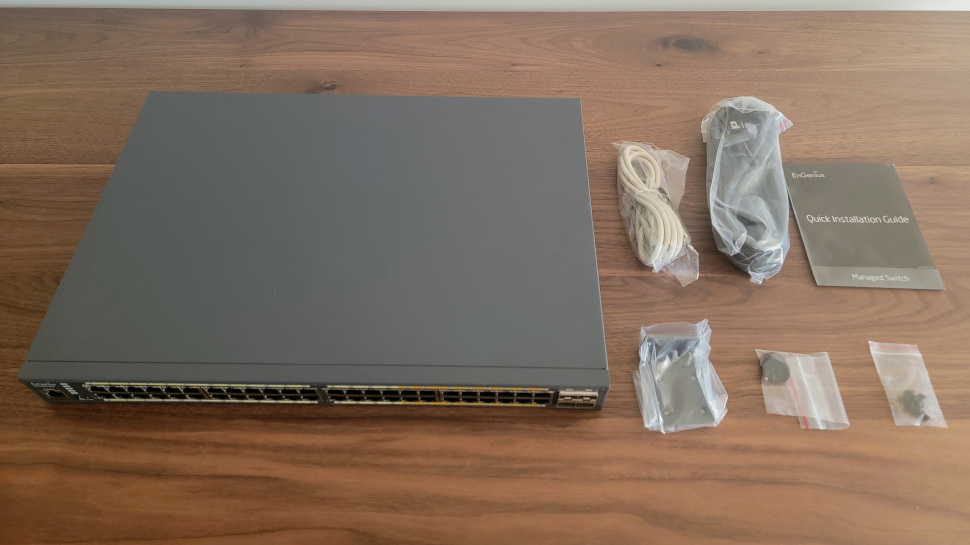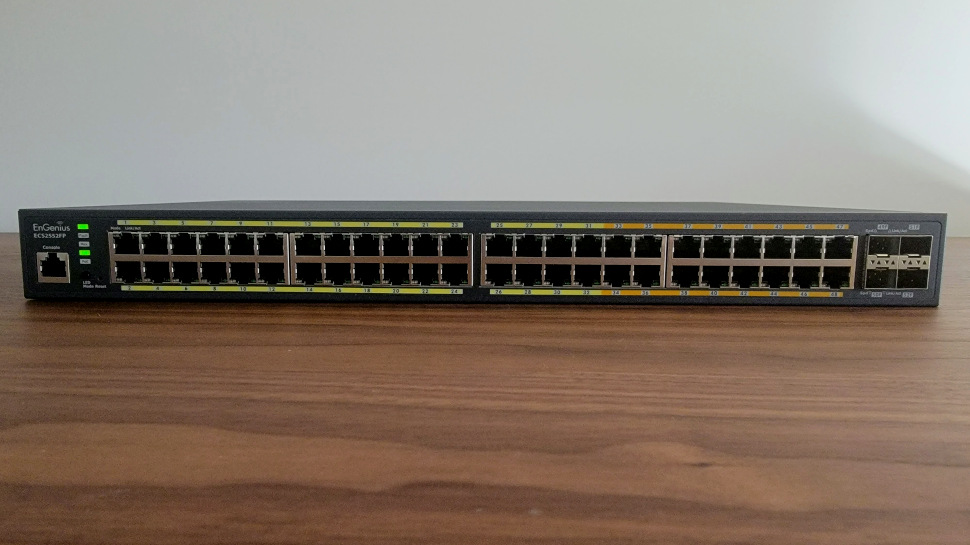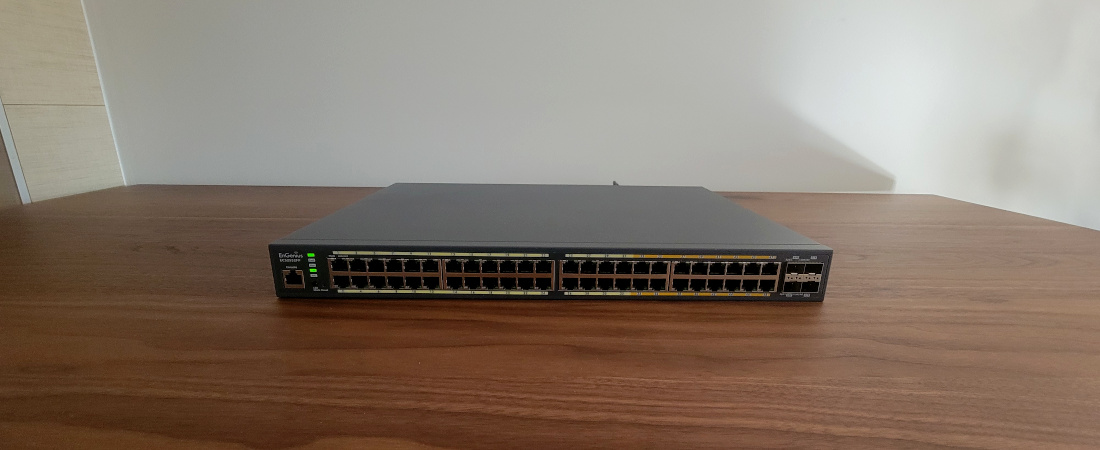TechRadar Verdict
The EnGenius ECS2552FP offers plenty of ports while boasting one of the highest PoE power for a $1600 switch. The snappy cloud interface and mobile app will make deployment and maintenance a breeze.
Pros
- +
740W of PoE power
- +
48 GbE ports
- +
4 10G SFP
- +
Great cloud support and mobile app
Cons
- -
Loud
- -
Flaky firmware update
- -
Dual purpose LED for ports
Why you can trust TechRadar
The EnGenius ECS2552FP managed network switch offers 32 x 1Gbps and 16 x 2.5Gbps copper Ethernet ports in addition to four SFP+ ports. It supports Power Over Ethernet (PoE) on all 48 copper ports with a power supply capable of 740W which is quite impressive for the form factor. The 224Gbps switching capacity is twice the throughput of all ports and should be more than enough to avoid any slowdown.
The EnGenius ECS2552FP offers Layer 2 and Layer 3 services such as VLAN tagging and QoS queues. It comes by default with a cloud-accessible GUI which is also available locally. The excellent mobile application includes most features available on the cloud. Things that we didn’t like are the always-on fan, the clunky firmware update process, and last but not least, the mode LED switch that can confuse the user.
EnGenius ECS2552FP: Price and availability
The ECS2552FP switch has an MSRP of $1599 with other available models ranging from eight ports with PoE (ECS1008P) to 28 ports without PoE (ECS1528). The ECS2552FP is ideal for a small business needing to have its communication infrastructure, surveillance, and data backup all connected to the same switch.

EnGenius ECS2552FP: Design
The ECS2552FP is a rackmount 1U unit with all communication ports located on the front panel. The dark grey metal box measures 31cm x 44cm x 4.4cm and weighs 4.9kg. The managed switch is shipped with a power cord, rack mount kit, mounting screws, an RJ-45 console cable, and a quick installation guide.
Three fans located on the left serve as air outlets and are always turned on, generating about 50dB of audible noise at a one-meter distance. This isn’t much of a problem in data centers but is unbearable on a desk in an office setting. The back of the switch holds a 120V-240V AC socket. The switch consumes about 30W when idle, without any Ethernet connections.
A console port, status LEDs, a LED mode switch, and a reset button are all located on the front. Each Ethernet port has two LEDs for mode and activity. The mode switch allows each LED to display either PoE or LAN status. The ports are divided into two color-coded groups. The yellow group supports up to 1Gbps while the orange group up to 2.5Gbps. Four 10G SFP+ slots are available to distribute data across several switches.
Power over Ethernet on the EnGenius switch is provided by a 740W supply available to all 48 copper ports. The switch PoE interface has been specifically designed to support cameras. Power can be sent over 250 meters while failed remote units can be detected and rebooted automatically. The ECS2552FP is also suitable for deep packet inspection and filtering, being powered by a dual-core 1GHz CPU along with 512MB of DDR RAM, and 128MB of Flash memory.

EnGenius ECS2552FP: In use
The EnGenius ECS2552FP boots in about four minutes. There is a small delay between the turn-on time and when the fans kick in. Five status LEDs are arranged vertically with the first three showing if the switch is connected to a network, if it detected any network faults or if the PoE is working properly. The remaining two give the state of the LED mode which can be either LAN or PoE. We were not a fan of the multi-mode LEDs since it is prone to confusion more than being helpful.
In order to use the switch to its full potential, registration of the device is required. This is done using the Cloud To-Go Engenius app and a QR code located at the bottom of the case. Once the setup is complete, the switch is accessible from both the cloud and the mobile application. The latter supports most features available on the cloud. The mobile app’s well-designed UI allows most configurations to be done in no more than four steps.
The cloud interface continues to work even when the switch is offline. This opens up the option of adjusting all settings offline and waiting for the unit to go online and be updated. This is a convenient way of provisioning the switch in a single event, hence reducing the likelihood of attacks that can happen during a live configuration.
New switch features are available for a fee from the EnGenius cloud service. The ProSW license is available as a one-year free trial with the purchase of the ECS2552FP and adds the ability to capture packets on-the-fly over multiple ports or to display a list of connected MAC addresses. The ProSW license also allows backup of the switch configuration.

EnGenius ECS2552FP: The competition
Investing in a good switch is something that will pay for itself over time. When configured properly, a switch will quickly transfer data between nodes while keeping an eye on the network’s overall health. Needless to say that the network switch market is crowded with the likes of Cisco and Broadcom. EnGenius provides a solution that is extremely simple to set up and operate.
The Netgear GS752TPSB switch offers the same basic feature as the ECS2552FP. It has 48 port 1GbE with six 1G/2.5G SFP slots. While priced at $1499, it offers only 384W of PoE power budget which is about half of what the ECS2552FP provides while also missing the 10G SFP+ ports.
EnGenius ECS2552FP: Final verdict
EnGenius takes designing products seriously. This is on display with its ECS2552FP network switch. An abundance of ports and an unmatched 740W of PoE power budget make this switch the one to get if there is a need to support dozen of PoE IP cameras or VoIP phones. Features include real-time monitoring of its PoE ports and automatic recovery from PoE failures. What makes the EnGenius switch standout is the snappy cloud interface and its companion mobile application. They are heads and shoulders above the competition.
The ECS2552FP isn't perfect by any means. The always-on fan is loud, even without any connected PoE devices. Upgrading the firmware requires some practice to get it right while the mode LED can be confusing at times.
My interest has been piqued by everything electronic since a young age, with a penchant for the dark art of tearing things apart. My daily duty is to marry software and hardware modules and I have to admit that this is much harder than cooking. When I’m not busy at work, I’m on the lookout for the latest and greatest hack! I am passionate about portable power generators (or power stations) as well as maker products such as the Raspberry Pi and any similar SBC (single board computers)

